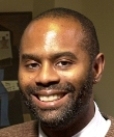Beginnings (1945-1967)
Black students first got involved with InterVarsity in New York City in 1945, when the student work at elite private schools spread to public schools in lower Manhattan and Brooklyn. Around the same time, Black students also began getting involved at Wayne State University in Michigan, helped by the relationship between C. Stacy Woods and B.M. Nottage.
In 1948, InterVarsity appointed its first Black staff, Eugene Callendar. A few years later in 1952, Ivery Harvey from Atlanta was hired as InterVarsity’s first full-time Black staff. Ivery planted chapters at Black colleges throughout the Southeast. In 1958, Ruth Lewis (Bentley) became the third Black staff worker and served throughout the Southeast.

Urbana 67 and 70: Prophetic witness
In 1967, 200 Black students attended the Urbana Student Missions Conference and, after an all-night prayer meeting, presented a petition to InterVarsity leadership. Paul Gibson, Elward Ellis, Bill Pannel, Ron Potter, Isom Herron, and Carl Ellis were part of the prayer meeting and shaped InterVarsity for decades afterwards. A year after Urbana 67, Paul Gibson, who had been part of the Harvard chapter, would become InterVarsity’s fourth Black staff and, with patience and persistence, would help InterVarsity slowly increase its sensitivity to Black student ministry.
At Urbana 70, a new voice to InterVarsity, Black evangelist Tom Skinner, called for a radical, just, Christianity that set people free spiritually and physically. The conference theme was Christ the Liberator. At the end of his talk reviewing Black history in America, Skinner declared that The Liberator had come.
A Growing Ministry (1970-1980)
New staffer Barbara Brown was sent to NYC for training with Paul Gibson in response to a proposal for Black student work Paul and Neil Rendall had put together after Urbana 70. Tony & Veronica Warner were recruited from Brooklyn College to work with InterVarsity at Atlanta University Center. With Tony, Barbara, and Paul InterVarsity had 3 Black staff working for the first time.
In the same year, Black staff formed the Black Staff Fellowship, and it became a key group for multiethnic growth and advocacy IV. It led to the first National Director of Black Campus Ministries and eventually the establishment of the MEM Department.
In 1975, the Southeast officially formed the SE Black Team with Tony Warner, Fred Williams, Felicia Bowens-Anderson, Alex Anderson, and others which had a vision for ministry to black students both at predominantly white colleges and universities, as well as a plan to reach HBCUs with bases in Atlanta, Raleigh, Jackson, Nashville, and Baton Rouge among the key places. Starting in 1976 there were conferences in the Atlanta University Center each March for several years.
In the seventies, before leaving InterVarsity to attend seminary, Paul Gibson cast a vision for InterVarsity to connect students with urban realities. Out of this vision, urban projects are birthed in the 1980s and 1990s, under leadership of staff like Brenda Salter-McNeil and Kevin Blue.
Building Black Campus Ministries (1980-2005)
In 1980, Elward Ellis was appointed as the first national director of Black Campus Ministries, after serving as a student leader and helping with multiple Urbana conferences. He established the BCM Exe Council, now called the BCM Leading Servants Team. Elward served as BCM director until 1987. A year later, Dr. Sheldon Nix was appointed the new BCM director.
 In the 1990s, the National Black Student Conferences in Atlanta helped grow BCM, the number of Black staff, and strategies to discuss racial issues on campus. In Los Angeles, Doug and Sandy Schaupp led events like Fudge Ripple and Race Matters. Ministry among campus gospel choirs developed. The Vision Conference, a Black student conference, would bear much fruit under the leadership of Brenda Salter-McNeil, York Moore, Stan Parker, Bob Hunter and Latina Williams.
In the 1990s, the National Black Student Conferences in Atlanta helped grow BCM, the number of Black staff, and strategies to discuss racial issues on campus. In Los Angeles, Doug and Sandy Schaupp led events like Fudge Ripple and Race Matters. Ministry among campus gospel choirs developed. The Vision Conference, a Black student conference, would bear much fruit under the leadership of Brenda Salter-McNeil, York Moore, Stan Parker, Bob Hunter and Latina Williams.
In 2002, BCM director Alex Anderson tragically died just before national staff conference bringing a somber mood to a conference planned around the Hebrew word Shalom. Shortly afterwards, Phil Bowling-Dyer was appointed as the new director of Black Campus Ministries.
 Under the leadership of the MEM Associate Director of Reconciliation, Jimmy McGee, the Pilgrimage for Reconciliation was held as an important step in our development of a theology of Shalom for our movement. The pilgrimage took place in back to back years (summer of 2003 and 2004).
Under the leadership of the MEM Associate Director of Reconciliation, Jimmy McGee, the Pilgrimage for Reconciliation was held as an important step in our development of a theology of Shalom for our movement. The pilgrimage took place in back to back years (summer of 2003 and 2004).
In 2003, Paula Fuller was appointed Chair of the Board, the first African American InterVarsity Board Chair. In 2005, she was appointed Vice President and Director of Multiethnic Ministries.
Looking to the Future (2006 - Present)
In 2006, to create a more robust career trajectory for our prospective Black and Latino Staff leaders, the First BCM and LaFe Daniel Projects were held under the leadership and direction of Phil Bowling-Dyer and Orlando Crespo.
In 2008, Black Scholars and Professionals was formally launched at the Graduate and Faculty national meetings.
In 2015, The BCM15 national student conference pilot was held at two sites, San Francisco and Detroit, and reached 690 students on 95 campuses.
Throughout this period, racial tensions in the nation and the Black Lives Matter movement sparks both solidarity and dissonance within InterVarsity, both on campus and through Michelle Higgins' address at Urbana 15. Black Staff engage in a pilgramage to Ferguson, MO following Urbana 15.
In 2018, Shaylen Hardy began her role as National BCM Director after serving as Associate National BCM Director alongside her predecessor Charlene Brown.
